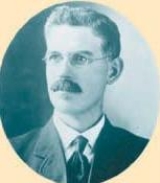
George S. Armstrong
Encyclopedia
George Seale Armstrong was a politician in Alberta
, Canada
and a mayor of Edmonton
.
. He came to Edmonton in 1905 or 1906, and ran for Edmonton City Council
as an alderman in the 1907 election
. He finished second of twelve candidates, and was elected to a two year term. He was re-elected in the 1909 election
, but resigned one year into his term in order to contest the mayoral election in 1910
. He was acclaimed as mayor, and was re-elected in 1912
. February 1, 1912 also saw the amalgamation of Edmonton on the north side of the Saskatchewan River, with Strathcona on the south side into greater Edmonton, with George S. Armstrong as the first mayor of the combined city. As mayor, he commissioned a master plan for the city from an American firm. He completed his term, but did not seek re-election.
He operated a drugstore from his arrival in Edmonton, and was involved in several real estate ventures and construction projects with his brother Gordon. He worked for the post office beginning in 1913, and became postmaster ten years later, a position he filled until his retirement in 1937.
He was a member of the hospital board, the Edmonton Exhibition Board, the Masonic Order
, and the United Church of Canada
. George Armstrong died June 9, 1947, survived by a wife, Jessie Mathieson Armstrong, one son, William Sloan Seale Armstrong and two daughters, Helen Armstrong and Jessie Watson.
Armstrong Industrial, an Edmonton neighbourhood, is named in his honour.
Alberta
Alberta is a province of Canada. It had an estimated population of 3.7 million in 2010 making it the most populous of Canada's three prairie provinces...
, Canada
Canada
Canada is a North American country consisting of ten provinces and three territories. Located in the northern part of the continent, it extends from the Atlantic Ocean in the east to the Pacific Ocean in the west, and northward into the Arctic Ocean...
and a mayor of Edmonton
Edmonton
Edmonton is the capital of the Canadian province of Alberta and is the province's second-largest city. Edmonton is located on the North Saskatchewan River and is the centre of the Edmonton Capital Region, which is surrounded by the central region of the province.The city and its census...
.
Biography
Armstrong was born in Hopeville, Grey County, OntarioGrey County, Ontario
Grey County is a county and census division of the Canadian province of Ontario. The county seat is in Owen Sound. The population was 92,411 in 2006. It is located in the subregion of Southern Ontario named Southwestern Ontario...
. He came to Edmonton in 1905 or 1906, and ran for Edmonton City Council
Edmonton City Council
The Edmonton City Council is the governing body of the City of Edmonton, Alberta, Canada.Members represent wards throughout the city, and are known as councillors. Until 2010, Edmonton was divided in six wards with two councillors representing citizens in each ward...
as an alderman in the 1907 election
Edmonton municipal election, 1907
The 1907 municipal election was held December 9, 1907 for the purpose of electing a mayor and five aldermen to sit on the Edmonton City Council, as well as five public school trustees and six separate school trustees...
. He finished second of twelve candidates, and was elected to a two year term. He was re-elected in the 1909 election
Edmonton municipal election, 1909
The 1909 municipal election was held December 13, 1909 for the purpose of electing a mayor and four aldermen to sit on the Edmonton City Council, as well as three public school trustees and five separate school trustees...
, but resigned one year into his term in order to contest the mayoral election in 1910
Edmonton municipal election, 1910
The 1910 municipal election was held December 12, 1910 for the purpose of electing a mayor and five aldermen to sit on the Edmonton City Council, as well as three public school trustees and five separate school trustees...
. He was acclaimed as mayor, and was re-elected in 1912
Edmonton municipal election, February 1912
On September 27, 1911, the voters of Edmonton approved by plebiscite the amalgamation of Edmonton with Strathcona. This amalgamation was effected February 1, 1912, and, in anticipation of this, no election was held December 11, 1911 as would normally have been required...
. February 1, 1912 also saw the amalgamation of Edmonton on the north side of the Saskatchewan River, with Strathcona on the south side into greater Edmonton, with George S. Armstrong as the first mayor of the combined city. As mayor, he commissioned a master plan for the city from an American firm. He completed his term, but did not seek re-election.
He operated a drugstore from his arrival in Edmonton, and was involved in several real estate ventures and construction projects with his brother Gordon. He worked for the post office beginning in 1913, and became postmaster ten years later, a position he filled until his retirement in 1937.
He was a member of the hospital board, the Edmonton Exhibition Board, the Masonic Order
Freemasonry
Freemasonry is a fraternal organisation that arose from obscure origins in the late 16th to early 17th century. Freemasonry now exists in various forms all over the world, with a membership estimated at around six million, including approximately 150,000 under the jurisdictions of the Grand Lodge...
, and the United Church of Canada
United Church of Canada
The United Church of Canada is a Protestant Christian denomination in Canada. It is the largest Protestant church and, after the Roman Catholic Church, the second-largest Christian church in Canada...
. George Armstrong died June 9, 1947, survived by a wife, Jessie Mathieson Armstrong, one son, William Sloan Seale Armstrong and two daughters, Helen Armstrong and Jessie Watson.
Armstrong Industrial, an Edmonton neighbourhood, is named in his honour.

